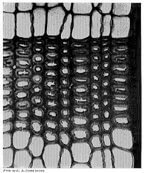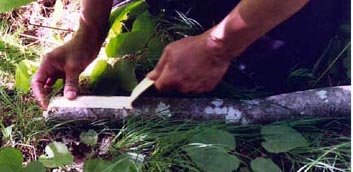Materials
The material properties of wood were very important to all native crafts. Not only the species of tree had to be taken into account in the craftwork, but also which part of the tree (branch, root, bark), the age of the tree (sapling or adult), the conditions in which it grew (soil, water, shade), the shape of the part of the tree extracted (e.g. curved or straight), and even the time of year. The belief that trees had "personhood" (Naagidewnjigon) helped to ensure ecologically sustainable harvesting: limiting root harvests to allow the tree to re-grow, for example.
Native artisans did not have microscopes, but their decisions on material usage reflects differences that we now know to be occurring at cellular or even molecular scales. For example, Earl Otchingwanigan (bottom right) is making cords for a wiigwaam by peeling strips of basswood (wiigwap) bark. He says that last year was very dry, and so the bark was more difficult to strip. Drying takes place at a cellular level (bottom left; the smaller cells at center have dried out).
When creating arcs, the wood must be both strong and elastic. For example, a soft wood like basswood has a modulus of rupture (how much weight it can take, epiichiiyimigak) of 4,500 lb/sq in, whereas the best native wood for making bows was osage orange wood, which can take 13,600 lb/sq in before breaking.

